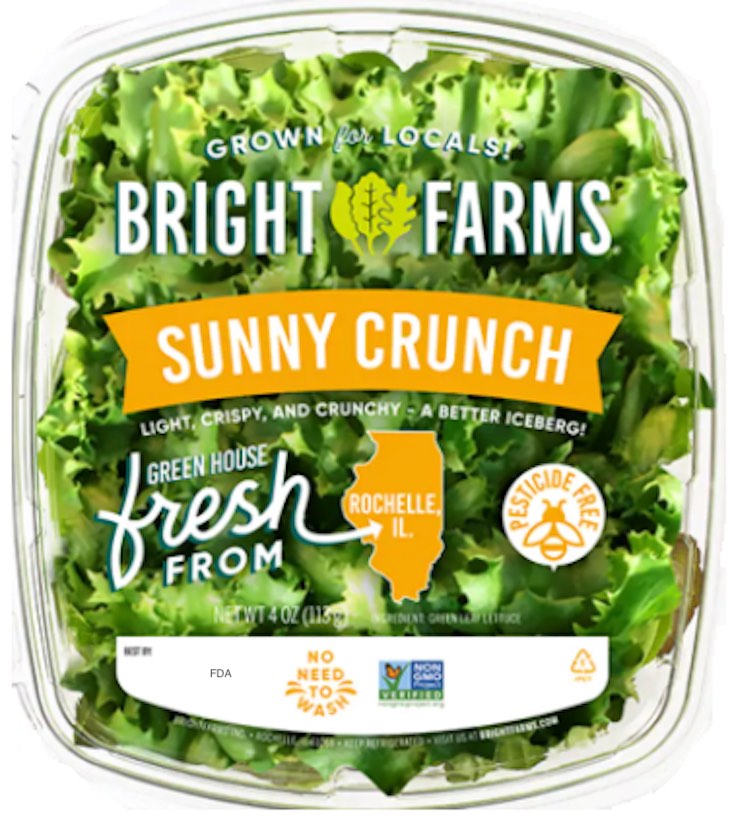Since mid-July, there have been two recalls for salad greens grown in greenhouses, one of them in conjunction with a multistate Salmonella outbreak. These recalls have some consumers wondering how does greenhouse-grown lettuce get contaminated with pathogens?
The first recall was linked to herbs and salad greens produced by BrightFarms of Rochelle, IL. On July 15, BrightFarms issued a recall for a variety of products packaged in clamshell containers and sold at grocery stores in five states. On July 22, health officials identified BrightFarms salad greens and herbs as the source of a Salmonella outbreak that has sickened 11 people in Illinois, Michigan, and Wisconsin.
In recent years, consumers have learned from a string of E. coli O157:H7 outbreaks that neighboring livestock farms can contaminate field-grown romaine lettuce. But how does the contamination occur when there are no fields?
“[I] suspect Salmonella could have been introduced via hydroponic nutrient solution and/or spread via post-harvest washing, Professor Keith Warriner, Ph.D., a Food Microbiologist at the University of Guelph, Center for Public Health and Zoonoses, told Food Poisoning Bulletin. “Hydroponics cultivation can actually be more susceptible to contamination vs. field grown.”
In 2003, Warriner was part of a research team that compared the growth of E. coli on spinach plants grown hydroponically and in soil. The study, published in the Journal of Food Protection, found that spinach seedlings transferred into a hydroponic system containing E. coli. will internalize the bacteria, meaning it can’t be washed off.

Days after the BrightFarms was announced, another recall for greenhouse greens was issued. On July 26, Old Soul’s Farms of St. Paris, OH recalled Arugula, Basil, Finstar, Green Bibb, Romaine, and Spring Mix for possible Listeria contamination. The recalled salad greens were sold in bulk in clear, plastic bags and as retail products packaged in plastic, clamshell containers.
In the recall announcement, Old Soul’s said Listeria monocytogenes was found in the rainwater holding tanks in the greenhouse facility and in a product sample that was tested by a customer. Collecting rainfall is a method used by both open-field farms and greenhouses. But how rainwater is collected and if it’s treated before it it is used to wash or irrigate crops is key.
Irrigation water and the application of fertilizer are the biggest risk factors for bacterial contamination on leafy greens, according to the authors of the 2014 study, Agricultural and Management Practices and Bacterial Contamination in Greenhouse versus Open Field Lettuce Production. In their comparison of agricultural practices, researchers found that pathogens such as E. coli, Salmonella, and Campylobacter turned up in 48 percent of water samples from open field farms versus 12 percent of samples from greenhouses.
Researchers noted two reasons for the dramatic disparity in those numbers. The first is that greenhouses are more likely than open-field farms to provide physical barriers that protect their water sources against bacterial contamination. Such barriers include using elevated reservoirs to prevent the entrance of runoff water, a known source of contamination that has been linked to many foodborne illness outbreaks.
The second reason is that greenhouses are more likely than open-field farms to use water treatment systems. The study authors concluded that water management is key to the production of safe leafy greens.
The Centers for Disease Control and Prevention (CDC) estimates that a large percentage of foodborne illnesses reported annually in the U.S. stem from contaminated produce. In particular, leafy greens and other row crops are a major source of E. coli O157:H7 infections reported each year. Other pathogens associated with leafy greens are Salmonella, Listeria, and Cyclospora.
Between 2014 and 2018, 51 food poisoning outbreaks were linked to leafy greens, in most cases lettuce, according to the CDC. The majority of these greens are grown on open field farms in Arizona and California, There were 1,406 illnesses associated with these outbreaks. And, because most infections aren’t associated with a confirmed outbreak, that’s a fraction of the actual number of food poisoning illnesses associated with leafy greens.




